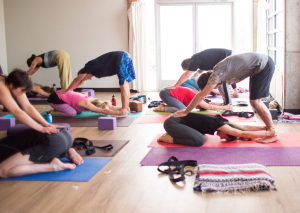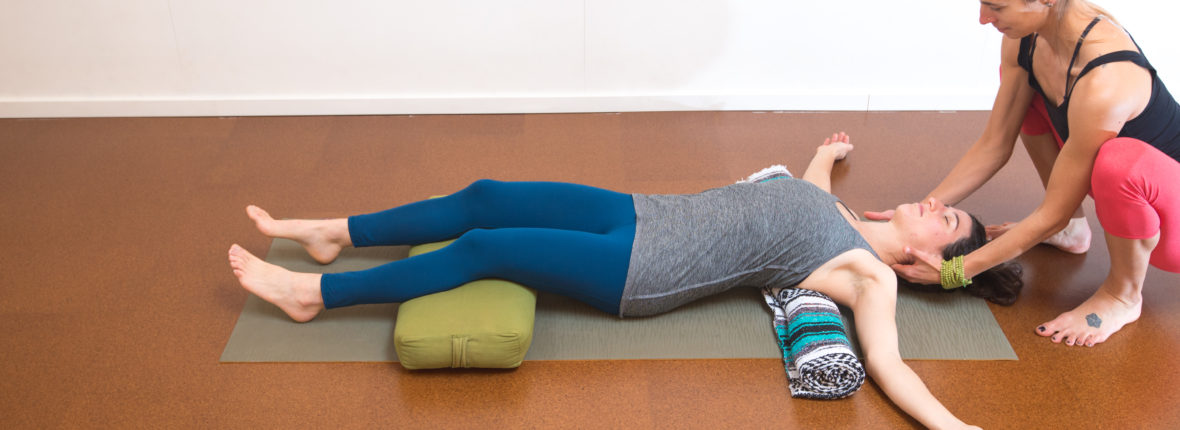“We’re in the middle of a sea change,” said Jason. “Most yoga teachers now are erring on the side of not giving manual adjustments, and for good reason.” It was the second day of our two-week module (the first part of a 300-hour training), and the conversation had shifted from “How to give hands-on assists” to “Should we give hands-on assists?” As you might imagine with a room of 50 teachers, there were a lot of opinions.
I’ll admit it: I love hands-on assists. Most of the time, I have a difficult time relaxing (no, the irony is not lost on me), but when I receive a caring touch, I melt instantly. A sacral press in child’s pose, a thigh-bone pull in down dog, a hand on the back of my heart in tadasana – I love all of it.
But I also know that not everyone does. In fact, for some of us, touch in a yoga class, no matter how caring the intent, is a violation of space and safety. What if a student has an injury that will be aggravated by an assist? What if they’re recovering from physical or sexual assault? What if they have experienced abusive touch in the past, and any unexpected touch is a trigger? The last thing they need is someone touching them without consent. To teach yoga with a trauma-informed lens, we are told that we must ask permission before offering manual adjustments.

Most of us yoga teachers have heard this before, and most of us have also probably ignored it at some point. I used to think that I could tell whether or not a person was okay with hands-on assists, just by observing their body and yoga practice. I used to think that if I gave the right assist – caring, yet professional in nature; meant to feel good, not simply to “correct” a pose – anyone would enjoy it, because how could they not?! I thought for a while that this was the generous thing to do: because I loved assists so much, I wanted everyone else to experience them. Then at some point, I realized this was the same logic used by cat-callers: “Hey! I’m just trying to give you a compliment! If someone told me I had a nice ass, I’d be flattered!” Guess what, buddy: not everyone wants to be told they have a nice ass, especially by someone they don’t know or trust. And guess what, yoga teachers: not everyone who comes into our class wants to be touched; they don’t know us, nor will they necessarily trust us immediately (or ever!).
My friend and co-worker, Molly Boeder Harris reminded me of all this (and more) in her training: Teaching Yoga With a Trauma-Informed Lens. In this training, we discussed teachers’ use of language, movement patterns, presence, and of course, their use of touch. She echoed the advice that I had heard and read from other trauma-informed teachers: don’t touch your students without asking permission.
The challenge with this is that, especially when we have large classes, it is dreadfully inefficient to ask each person individually, “Are you okay with hands-on assists?” before we offer one. There’s also the problem of the leading question. To ask “are you okay with…” implies that by saying “no,” that person is “not okay.” But to ask a more neutrally phrased question such as “How do you feel about hands-on assists?” is even more inefficient, as it warrants an essay response when there is really only time for a one word answer.
The solution? Many teachers have adopted the habit of saying toward the beginning of class, “If anyone doesn’t want assists, please raise your hand/ leg/ put your hand on your heart now.” The challenge with this (apart from the fact that it is again framed in the negative) is that who in the Sam Hill is going to remember who raised their hand/ leg/ put their hand on their heart?! Someone smarter than I, I guess.
So what are we left with? Flip chips? (Cool, but expensive.) Signs on each person’s mat? (A little over-the-top.) Telepathic communication?! (I’ll keep practicing…)
I was searching through the drawers at the studio one day, looking for something – anything – I could use for this purpose, when I happened upon a box of paperclips.
 I wondered: What if students secured a paperclip to one side of their mat if they like assists, and the other side if they don’t? Then everyone has a paperclip (no one is singled out), both options are presented neutrally, and students can keep them on their mats for next time they’re in class! (And if we lose a few clips, who cares – they’re dirt cheap!) It’s not as aesthetically pleasing as a flip chip, but at least it will do for now, I thought. And so it was proclaimed: take a clip, and put it on the front right side of your mat if you really like assists; front left side if you’d like to be left alone. (Or, as one student later said: “Right on, hands on; left for left alone.”)
I wondered: What if students secured a paperclip to one side of their mat if they like assists, and the other side if they don’t? Then everyone has a paperclip (no one is singled out), both options are presented neutrally, and students can keep them on their mats for next time they’re in class! (And if we lose a few clips, who cares – they’re dirt cheap!) It’s not as aesthetically pleasing as a flip chip, but at least it will do for now, I thought. And so it was proclaimed: take a clip, and put it on the front right side of your mat if you really like assists; front left side if you’d like to be left alone. (Or, as one student later said: “Right on, hands on; left for left alone.”)
A year later, I am still using this system. In that year, some students have asked, “What if we like assists as long as you warn us first?” We decided that placing the clip in the middle of the mat would remind me to alert them first (the assist continuum!). Many have also asked, “What is a hands-on assist?” which has led to a brief definition or demonstration of what one might expect in an assist. (What is obvious to us teachers is not always obvious to our students!) And just as this system has allowed students who prefer no assists to remain untouched, it has allowed students who love assists to receive more of them; I am no longer hesitant when I offer an assist, because they have already (and recently) given consent.
Touch can be profoundly healing; it can also be triggering. Skillful assists can illuminate a certain pose, part of the body, or movement; they can also disrupt. I do not want to stop receiving assists, nor do I want to stop giving assists to those who love them. I do want everyone in class to feel safe and cared for. Whether this safety and care comes through a confident and caring assist, or leaving a student be, the student must be the one to decide.


When I started doing yoga a few years ago it was at a studio that was pretty assertive about assists. I happen to love them but I wondered at the time about others. When I moved to PDX and discovered People’s yoga and your classes, I thought your paper clip strategy was pure genius. Just thought you should know that.
Hi All im rookie here. Good post! Thx! Love your stories!
Hi,
Nice Post, Thanks for sharing lovely information.
Keep posting
Hi,
Great Post, Thanks for sharing this valuable information regarding yoga blog. This blog post will be very helpful for peoples. Keep sharing !!